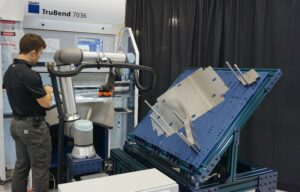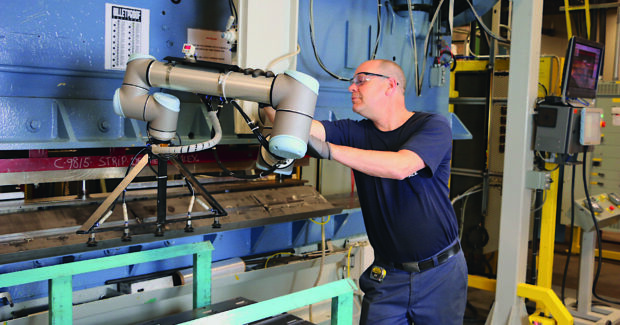Collaborative Press Brake Automation Gives Companies Reason to Celebrate
Cobot-powered press brakes provide a cost-effective way to overcome the ongoing labor crisis.
Posted: January 17, 2023

Collaborative robot (cobot-) powered press brake automation provides an effective way for companies of all sizes to boost productivity and throughput, enhance ergonomics, and cut cycle times.
Today’s cobot-based systems employ intuitive programming techniques (such as hand guiding) and software interfaces that anyone can pick up regardless of their previous robotics experience. It’s a far cry from the cost and complexity of traditional press brake automation.
The primary driver of cobot-powered press brakes is that they provide a cost-effective way to overcome the ongoing labor crisis that’s hitting companies of all sizes. Cobots take care of repetitive and unergonomic manual press brake applications, enabling companies to staff previously unfillable roles and improve workplace ergonomics.
Moreover, cobot-powered press brake systems improve quality by ensuring consistent bends, time after time. Other major drivers of cobot-powered system adoption include lower Total Cost of Ownership (TCO), smaller footprint, and improved usability versus traditional press brake automation.
Collaborative press brake automation can be deployed in numerous ways, from stamp press tending on night shifts to day shift pick-and-place tasks designed to improve ergonomics for human workers.
Ready, Out-of-the-box Solutions
But not all cobot-based systems are the same.
First, look for ready out-of-the-box solutions that provide all the specialist hardware and software you need to get your press brake application up and running quickly, safely and effectively. This will save engineering time that would otherwise be spent on cobbling together different components to create an effective system. To streamline the process, start your search in an established ecosystem of automated press brake application kits.
Payload and reach requirements will vary depending on the application, but if you want your cobot to handle large sheet metal parts and extend the application potential of the system, make sure that it has sufficient reach and payload capacity. Payloads up to 16 kg (35.3 pounds) with a reach of 900 mm (35.4 in.) are widely available today. (For those wanting to handle even bigger payloads, note that a cobot with a 20 kg (44.1 pounds) payload and 1750 mm (68.9 in.) reach will hit the market later this year.)
Training is key to getting buy-in from end users, ensuring a successful deployment. Does your cobot provider supply sufficient free, online training resources? Can you get a hands-on demo to see the system in operation before buying? Give your company reasons to celebrate by investing in systems with well-established training resources.
More generally, the number one integration issue with stamping applications is getting the signalling right between the automation and the stamping press. If this is your company’s first automation project, then it will likely be beneficial to have an integrator help with the deployment.
Finally, embrace simplicity by tackling the easy applications first. Starting small in this way ensures faster ROI and allows you to build on your experience before taking on more complex tasks.
Subscribe to learn the latest in manufacturing.

















